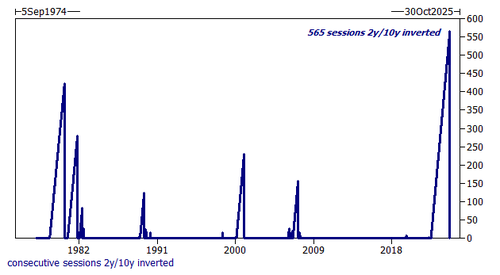What Happens After The Yield Curve Disinverts
This article is so good
it's for premium members only.
Does that sound like you?
PREMIUM
ONLY $30/MONTH
BILLED ANNUALLY OR $35 MONTHLY
All BASIC features, plus:
- Premium Articles: Dive into subscriber-only content, market analysis, and insights that keep you ahead of the game.
- Access to our Private X Account, The Market Ear analysis, and Newsquawk
- Ad-Free Experience: Enjoy an uninterrupted browsing experience.
PROFESSIONAL
ONLY $125/MONTH
BILLED ANNUALLY OR $150 MONTHLY
All PREMIUM features, plus:
- Research Catalog: Access to our constantly updated research database, via a private Dropbox account (including hedge fund letters, research reports and analyses from all the top Wall Street banks)
As noted in our Wednesday market wrap, after 26 months, or 565 trading sessions of inversion, yesterday the curve finally disinverted, marking the end of the longest 2y10y curve inversion in 50 years. What this means is a matter of furious debate.
On one hand, there are those like Bloomberg's Simon White, who argue that as a result of the trillions in (excess) reserves sloshing in the system, and repo becoming the primary money-market instrument, the "Yield Curve Is Now Broken As A Recession Indicator" and has become completely meaningless as a market signal.



